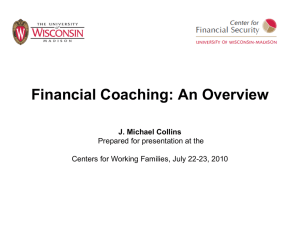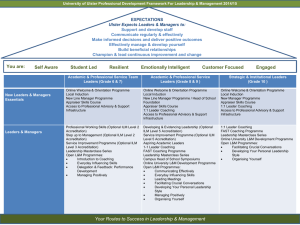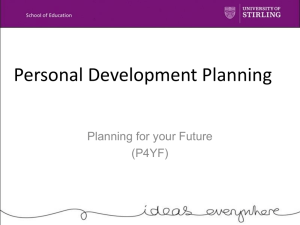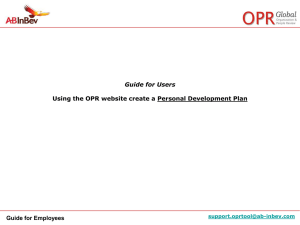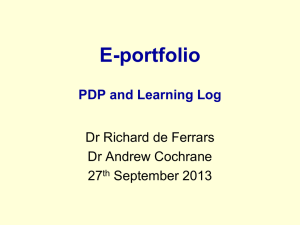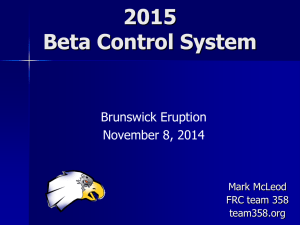Training for Trainers: Slide presentation - Person
advertisement
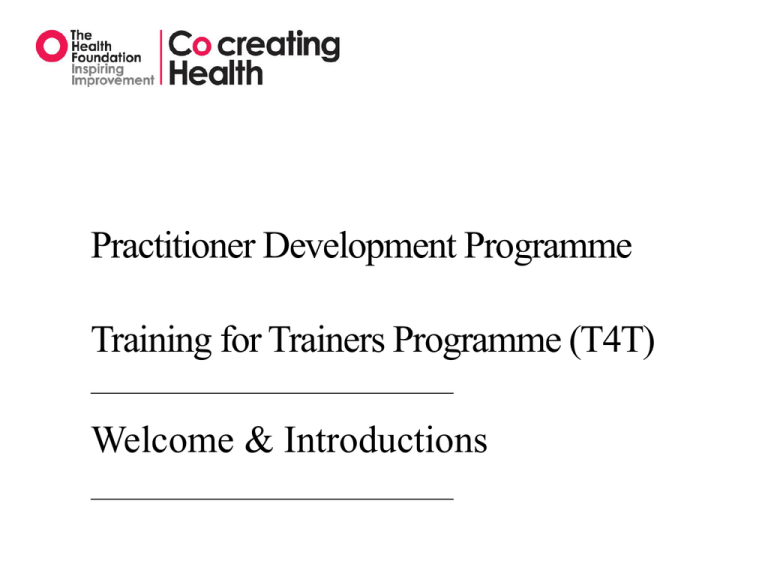
Practitioner Development Programme Training for Trainers Programme (T4T) Welcome & Introductions Welcome and Introductions • • Tutors House keeping; -Manage self -Toilets -Fire alarm & exits -Refreshments -Mobile phones Introductions Everyone introduces themselves, together with their role and where they work and one thing they would like the group to know about them. Aims of T4T - overview • To introduce clinical and lay tutors to the content and skills required to deliver the CCH Practitioner Development Programme (PDP) • To increase confidence and competence to deliver PDP • To support new trainers to develop individualised goals and action plans • To develop strategies for integrated partnership working between lay and clinical co-facilitators • To be the first step on the journey of continual development for PDP trainers Baseline questionnaire • Please complete the pre training questionnaire and return to the facilitator. • This questionnaire will be repeated at the end of the Programme and will enable you to assess your development and will contribute to the programme evaluation • Thank you Aims for facilitation team • Increase confidence in ability to present to clinicians • Increase understanding of the clinician’s journey to support self-care and develop empathy for clinicians at all levels in the journey • Increase understanding of the specific skills and techniques taught in the PDP • Increase confidence to tell story of journey of self-management highlighting concepts of Importance, Confidence, and use of Problem-Solving • Increase confidence to present the techniques of Problem-Solving, using example real life examples • Increase confidence to present ambivalence as a normal experience for a person living with a long-term condition using real life examples • Increase confidence in ability to facilitate skill rehearsal with actor • Develop a plan for continued co-facilitator skill development Role of the Facilitators Work in small mixed groups of three or four • Share your experiences of your own self management journey or your experiences of supporting self management • Consider how these experiences may impact your role as a tutor • Consider how you might reflect on your experience and describe these to delegates within a PDP training programme. • What support and strategies might you need to deal with your personal frustrations and emotions to enable you to use this experience in a training environment? • Debrief as a large group Experiences of the PDP and skills Work in [different] small mixed groups of three or four • Discuss your successes and challenges of using the PDP approach • Agree and record your top 5 successes and your top 5 challenges • Discuss your successes and challenges of using the PDP skills Whole group debrief then; • Identify your learning goals for the skills revision session Individual learning agenda • Individual learning agenda to inform skills revision Skills revision session • Key revision session for ensuring all delegates are confident with the PDP skills (in the communication skills descriptor list), how to use them, linkages and flow Practitioner Development Programme Training for Trainers Programme (T4T) Coaching & feedback Key tools for supporting behaviour change • • Good quality coaching and feedback are key tools for supporting individuals to develop confidence and competence in self management support skills. All new skills develop over time, becoming easier with practice. Interactive exercise; Split into smaller groups and explore ways that you have received feedback in the course of your personal and professional lives. How did these methods make you feel and what was their impact? What are the key qualities of constructive feedback, what should be avoided? Come back & debrief as a large group Coaching; definition • Relationship and rapport is part of the process, safety is key • Focus on enabling and empowering the learner • Goal is reaching a higher level of performance Coaching; the challenge • Coaching and giving coaching feedback is a new skill for many of us • We may need to give coaching feedback to a range of workforce groups • Coaching and feedback from lay facilitators may be a new experience • We need to be confident SMS practitioners, facilitators and coaches • Consider your own learning needs and goals • Making sure you use and model the skills and approaches in PDP will increase your confidence for skill spotting and to give constructive coaching feedback • Having lots of examples from your own practice will build credibility Coaching; the process outline • Set learner agenda and invite goal • Assess level of importance and confidence • Agree process & negotiate time outs and duration • Goal is reaching a higher level of importance • Continual process of improvement in skills and confidence Support handout available Coaching; the process steps • Pre –performance : seek learner agenda & set goals • Performance (negotiate time-outs and time) • Post-performance (feedback) • Refine learner agenda • Re-rehearsal • Summarisation, next steps Coaching; the detail • Clarify process • Establish learner’s goals • Assess Importance and Confidence • Set up the scenario • Have a go • Pause • Feedback, use the feedback grid (handout 2) to record your observations • Have a second go and feedback again Coaching • Demonstration • Small group practice Coaching; Debrief & action plan • Whole group de-brief • Individual action plan Practitioner Development Programme Training for Trainers Programme (T4T) Workshop overview The workshops • Briefly describe the workshops with short summary overview of key content • Elicit questions and learning agenda Practitioner Development Programme Training for Trainers Programme (T4T) Facilitators working in partnership Facilitators in partnership • Equal partnership • Part of integrated team • Joint responsibility • Team inputs and outputs • Value and respect • Utilise skills and experiences • Consider context of delegates • Consider context of facilitators Facilitation interactive exercise • Split into pairs with one lay and one clinical facilitator. • Each pair takes an interactive exercise from the PDP and creates an action plan for delivery. • One group facilitates their interactive exercise with the whole group. • The participants in the exercise give constructive coaching feedback. Coaching; More practice • Small group practice Practitioner Development Programme Training for Trainers Programme (T4T) Facilitation & Presentation Skills Group discussion • Essentials of good presentation • Essential of good facilitation • Flip chart responses Skills grid • Review the elements of the skills grid (T4T handout 5) • Explain each section • Consider you confidence for each section • Write your action plan to address areas of lower confidence • Use the grid to inform how your action plan for ongoing learning and continued development Practitioner Development Programme Training for Trainers Programme (T4T) Working with Simulated Patients Valuable resource • Develop rapport & relationship with your simulated patient(s). • Accept them as a valuable resource and as a part of your integrated team. • Provide adequate training and preparation time. • Include simulated patients for the part of the session debrief and workshop evaluation that relates to their role and share the evaluation • Agree basic principles in advance such as feedback in role, no comment or judgement on learners ability to use skill • Discuss any areas of concern on either side at the end of the workshop and agree action plan for next time Practitioner Development Programme Training for Trainers Programme (T4T) Culture of continuous Improvement Personalised health/care planning, self management support and shared decision making Activation The knowledge, skills and confidence to manage your own health and healthcare Working in partnership Sharing decisions Planning care Activated patients Prepared, proactive teams Optimal functional and clinical outcomes Living with a Long Term condition Usual care is self management Hours with professional / NHS = 3 in a year Self care / management = 8757 in a year People who live with LTCs are the ultimate decision makers and risk takers About lifestyle About medication adherence Decisions About accessing services About possible planned interventions So it should be the job of the service to ensure that…. …People are supported to make informed and personally relevant decisions about managing their own health and healthcare Am I going to stick to that exercise regime? Should I take that pill today? Do I really want that heart operation? Personalised health/care planning, SMS and SDM Scheduled follow up appointments, providing motivational support Scheduled care planning appointments, providing proactive support through partnership working Shared decision making Decision aids Scheduled care pathway, providing specific interventions Continuous Quality Improvement Is just a way of helping an organisation to consider and implement change Model for Improvement What are we trying to accomplish? How will we know that a change is an improvement? What change can we make that will result in improvement? Understanding the problem. Knowing what you’re trying to do - clear and desirable aims and objectives Measuring processes and outcomes What have others done? Langley G, Nolan K, Nolan T, Norman C, Provost L, (1996), The improvement guide: a practical approach to enhancing organisational performance, Jossey Bass Publishers, San Francisco Act Plan Study Do What hunches do we have? What can we learn as we go along? Outcome Secondary Drivers Organisational Changes Patient / Clinician Engagement Pre Visit Changes The 3 Enablers During Visit Changes Patient Confident in Self Management Ideas for Change Agenda Setting Goal Setting Goal Follow Up Post Visit Changes 42 Appendix 2 Self Management Questionnaire To help us to continually improve our services we would be grateful if you would kindly answer the following 6 questions. HAVE YOU ATTENDED A SELF-MANAGEMENT PROGRAMME? In your consultation today: YES/ NO (please circle) (please circle) YES/ N0 1. Did you Discuss what was most important to You in managing your own health? 2. Did you Get support to set a short-term goal for yourself? YES/ N0 3. Did you Arrange to discuss your progress on your short-term goal? YES/ N0 4. How supported did you feel in managing your health? 10 9 8 7 6 5 4 3 2 1 0 Totally Not at all supported supported “I am confident that I can manage my health condition” 10 9 8 7 6 5 4 3 2 1 0 Strongly Strongly agree disagree Continuous Improvement; interactive exercise • Work in groups of three or four • Record on a flip chart all your examples of continuous improvement • Consider how these examples will support the PDP workshop content • Feed back to the whole group one example per group of how you integrate this into the PDP workshops Coaching; More practice • Small group practice Practitioner Development Programme Training for Trainers Programme (T4T) Competency model Competency • Individual timescales • Review skills confidence grid domains • Set own continuing development action plan • One series observation co-facilitation with coaching feedback (using feedback grid and peer review form) • Negotiate with co-facilitator • Facilitator skill mix • Yearly peer review Continuing development & support • Consider local training programmes • Facilitation skills accreditation • Presentation skills accreditation • Regional and national initiatives • Knowledge & skills framework • Appraisal • Peer tutor groups & Action Learning Sets • Regular tutor meetings Individual action plan • Goal & action plan • Importance and confidence • Potential barriers • Problem solving • SMART • Confidence • Follow up plan Free space • Collaborative agenda setting for using this time End of training questionnaire • Please complete the post training questionnaire and return to the facilitator. • This questionnaire will be repeated at the end of the Programme and will enable you to assess your development and will contribute to the programme evaluation • Thank you Acknowledgements All logos of sites and phase 1 contributors required these also need to be on sheet inside front page


